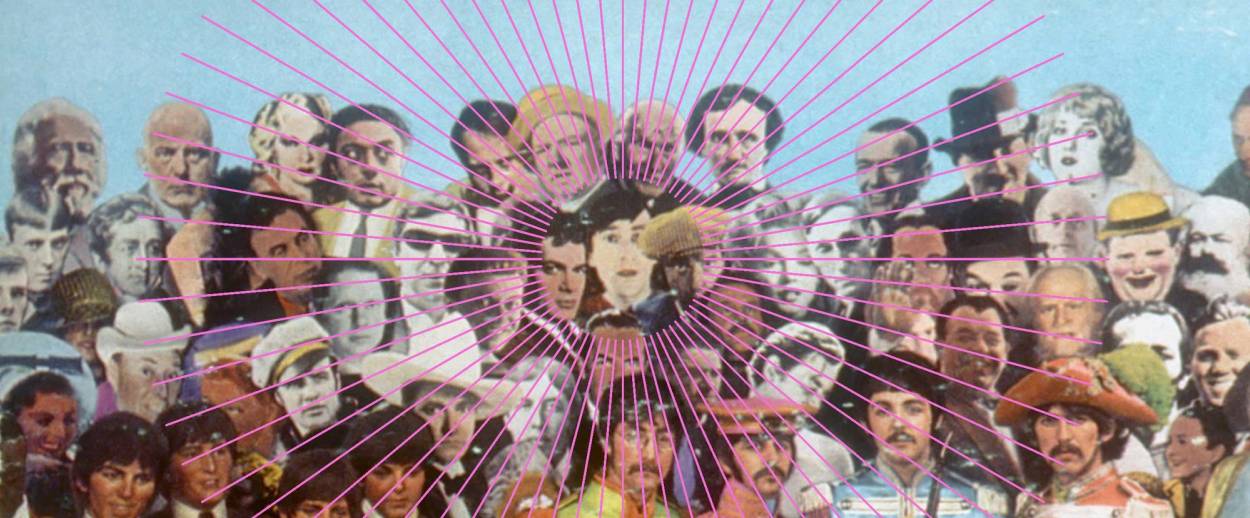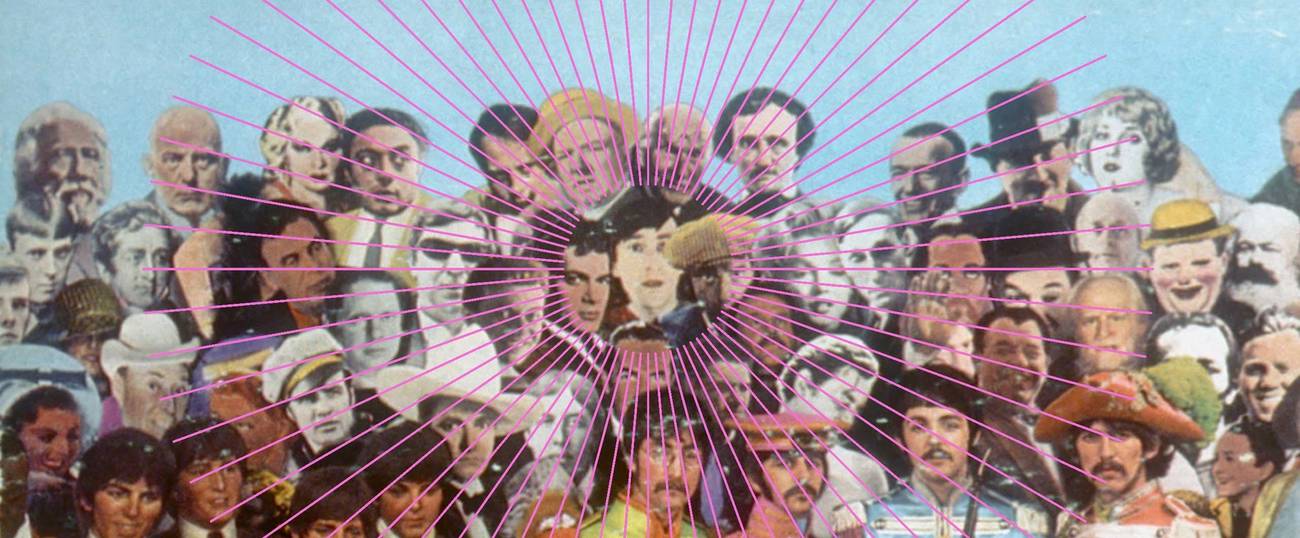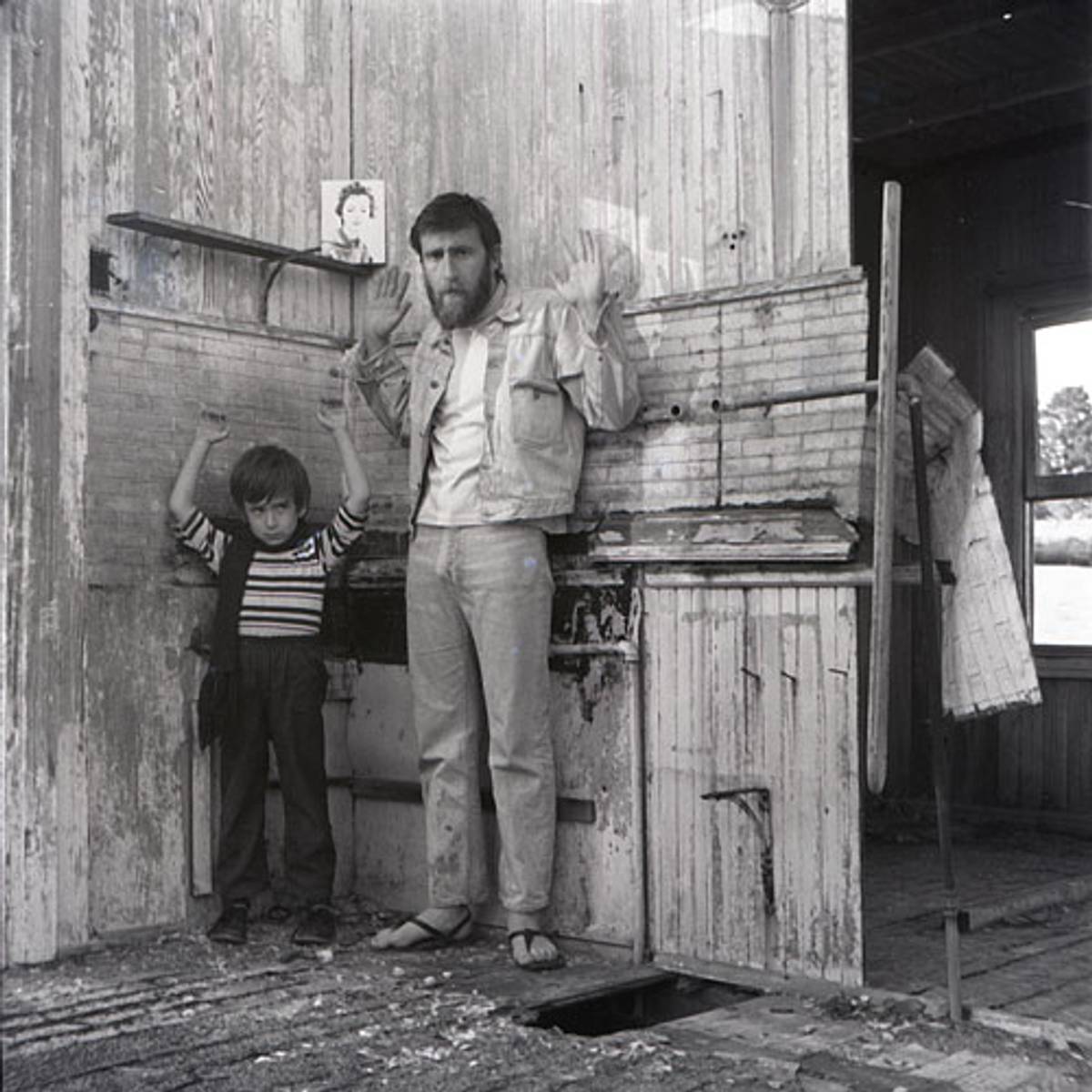The Mystery Poet on the Cover of Sgt. Pepper’s
National Poetry Month: Wallace Berman’s son pens a memoir of the temple the Kabbalistic Beat artist made of his own life




“If you’re interested in experimental art and Jewish mysticism, you need to go out and investigate Wally Berman’s work. But you’ll have to do some digging to get to it,” said late legendary Beat poet David Meltzer, concluding what turned out to be our last conversation. The weight of that moment stayed with me for the past two years, before an opportunity to follow through presented itself: I heard about an upcoming memoir by Wallace Berman’s son, Tosh, and arranged a meeting. Before long, I’ve come to realize just how right Meltzer was. As it happens, I now also understand the mischievous smirk that accompanied his comment.
Inasmuch as it is possible to be both iconic and unknown, Wallace Berman embodied that unlikely contradiction. One of the 70 faces on the Beatles’ Sgt. Pepper Lonely Hearts Club Band cover (1967), he is not as easily recognizable as Marilyn Monroe, a tad over to the right. Neither is his work the subject of endless academic conferences, as is the case for Carl Jung, who hovers immediately above. Yet, as a collage and assemblage artist, often associated with the Beat movement, Berman created radical, challenging, spiritually charged experimental works that touched his contemporaries. Ushering the readers into Berman’s milieu in Tosh: Growing Up in Wallace Berman’s World, Tosh Berman describes his father’s circle of influence, which included experimental artists and poets as well as famous musicians and Hollywood actors.
The single strangest and most mysterious aspect of Berman’s work is his obsession with Hebrew letters. Collaged into advertising images and newspaper clippings, painted on small rocks or a gigantic slab of dolomite, these letters are perfectly shaped and yet never stylized, as if penned by a meticulously pious scribe. Stranger yet, the letters never add up to recognizable words.
Instead, as art historian Ken Allen writes in his essay “Radio-Mastery of the Ether: Wallace Berman, Mysticism, and Meaning in the 1960s,” they seem far more like “transcriptions of some live broadcast … received out of the ‘ether’ like a radio signal.” Allen’s description is particularly apt, given Wallace’s other ubiquitous trope—that of a small AM/FM handheld transistor radio. It is as if, recreating an image of his world, the artist pricked reality’s thin veil, and the Hebrew letters bled outward and tumbled with little regard to the semantic context of their appearance.
When I traveled to Los Angeles to meet Tosh Berman at Kohn Gallery, which represents the artist’s estate, I immediately asked about the letters. “I was raised with no religious overtures or undertures,” quipped Tosh. Describing his father, Tosh continued: “He didn’t understand Hebrew, but what he did know was the pronunciation, and some of the basics. … He knew the tonkier version of the Jewish culture,” he laughed, referring to the darker, more esoteric mythology and hermeneutics, loosely associated with Kabbalah. “If it was forbidden, he was for it.”
Today, of course, the forbiddenness of Kabbalah is overshadowed by New Age manuals. In the 1960s, however, the exoticism and inaccessibility of Kabbalistic writings helped reinforce its esoteric aura, and drew the attention of numerous poets within Berman’s circle, including David Meltzer and Jack Hirschman, who saw it as a poetic, rather than a didactically religious, practice.

“Kabbalah appeals directly to poets because it is the kind of alchemy that engages with the materials of writing: the word, the letter, and the book,” writes scholar and thinker Stephen Fredman in Surrealism Meets Kabbalah: Wallace Berman and the Semina Poets. “In Kabbalah, all of the levels of occult ‘work’ … can be found, as they would be in any esoteric system, but all derive from investigation of language and culture.”
Tosh, who throughout his youth spent lots of time in his father’s studio observing his work, told me that the image of the transistor radio that appears on many of Berman’s collages came “from a Sony ad in a magazine. Transistor radio was an incredible invention. You can bring the news to the beach, you can walk out of the house and have that radio in your hand, that media there.” In his collages, Berman would overlay the speaker section of the radio with images, or as Tosh put it, “he made the sounds into a visual interpretation.” It is almost impossible to see his transistor assemblages today without thinking about smartphones.
Wallace Berman was born in 1926 on Staten Island, New York, but spent much of his childhood in the Fairfax neighborhood of Los Angeles, which was then heavily Jewish. However, as Tosh told me, Wallace was far more interested in South-Central Los Angeles, and other predominantly African American neighborhoods, where Berman frequented jazz clubs. “I’ve been told by my mom that he’s never been to a temple. He had no interest in those types of places,” said Tosh. Yet in his first public exhibit, Berman “turned his gallery into a temple,” as fellow visual artist George Herms recalled, speaking to Rebecca Solnit (see Solnit’s Secret Exhibition). Indeed, the Ferus Gallery installation contained Jewish and Christian spiritual symbols, including parchment-like pieces with scattered Hebrew letters on them, as well as a large cross. “This is, like, my church,” said Tosh Berman in our interview, imagining his father’s thought process.
The spiritual dimension of the exhibit was completely lost on the LAPD, which raided the gallery and arrested Berman on charges of obscenity—because one of the images was sexually explicit. Berman was convicted. It was the only public exhibit Berman held in his lifetime—though he received further exhibitions after his death in 1976 when, on the day of his 50th birthday, he was hit and killed by a drunk driver.
Despite the Ferus Gallery fiasco, Berman’s propensity for creating sacred spaces continued. One such sacred space was the Berman family apartment, where artists of all stripes would come together to speak about art and listen to records. “It was not a salon. … It was never academic. No crackers and cheese. Somebody had to run to the liquor store and get wine,” Tosh recalled.
Describing the houseguest regulars in his memoir, Tosh Berman refers to visits from Brian Jones of the Rolling Stones, Andy Warhol (who shot the opening scenes of Tarzan and Jane Regained … Sort Of in Berman’s living room), and the actors Dean Stockwell, Dennis Hopper, and Russ Tamblyn.
Above all, Berman’s residence was a haunt for poets—Allen Ginsberg, David Meltzer, Michael McClure, Jack Hirschman, Diane di Prima, and others. As Tosh told me in the interview, “My dad felt that poetry was the foundation of everything. And he read poetry not only as literature, but also as a visual artist.”
It is perhaps for that reason that his iconic magazine, Semina, contained so much poetry. The magazine was handmade and distributed only to people Berman deemed worthy of receiving it. In a way, Semina was another one of Berman’s sacred spaces, where countercultural artists of the day observed each other’s experiments.
Despite Berman’s active role in the artist community, he remained silent about his own work and his methodology. In the memoir, Tosh recalls the time Al Aronowitz, a New York Post reporter seeking to describe the West Coast’s Beat scene, interviewed Berman. The artist regretted the interview shortly after its occurrence and tracked the journalist down in his hotel to destroy the tape of the interview. As it happens, the tape contained interviews with other Beat icons Neal Cassady and Jack Kerouac. Berman’s reluctance to speak of his art, or in general, is reiterated throughout the memoir, though perhaps most poignantly here: “Wallace and I never really talked. He communicated more in silences than in chitchat.”
Berman’s archive at the Smithsonian contains a transcription of his freewheeling, free-associative ramblings recorded by a friend during Berman’s visit to London: “the letter Beth which is the mouth as mans organ of speech … his interior … his habitation … when in conjunction with the one preceding it … the Aleph forms all ideas of progress … of graduated advance … the passage of one state into another … locomotion … impossible for me to talk about … dig the work … it’s all there.”
In other words, to Berman, Hebrew letters weren’t merely sonic components of words, but hieroglyphic signifiers, each carrying a host of its own energies and associations. The one Hebrew letter Berman used by far the most was the Aleph.
As Stephen Fredman evocatively writes, for Berman, “The aleph took on a transformative, sacralizing function, as though it were capable of conferring a blessing upon a degraded, commodified reality.”
In that way, Berman’s Aleph may have evoked a complex representation of a self: For someone far removed from conventions of ethnic and religious establishment, “Jewish American” would be a weak and meaningless label. To be, instead, an American Aleph—a mind filled with media-fed images but containing within that one decontextualized ancient letter a drop of mystical tradition cutting across it all, existing within and breaking through—that is a far more complex and interesting approach to a self.
But what does it mean for an artist to use a language without knowing it intimately? Can Berman’s art be contextualized within the body of Jewish mysticism? Could he have been participating in the culture he was not truly conversant in?
There are no obvious answers to this question. Yet, looking through Smithsonian’s digitized collection of Berman’s archive, I stumbled on an unnamed poem by David Meltzer, published in the second issue of Semina, which perhaps encapsulates the enduring influence of both of these artists and the legacy of their cultural moment:
a second
Un-named You or Me or Somebody Else
escaped into a breast of a poem
and was never found again in time
but laughed pain into poets everywhere
Jake Marmer is Tablet’s poetry critic. He is the author of Cosmic Diaspora (2020), The Neighbor Out of Sound (2018) and Jazz Talmud (2012). He has also released two jazz-klezmer-poetry records: Purple Tentacles of Thought and Desire (2020, with Cosmic Diaspora Trio), and Hermeneutic Stomp (2013).